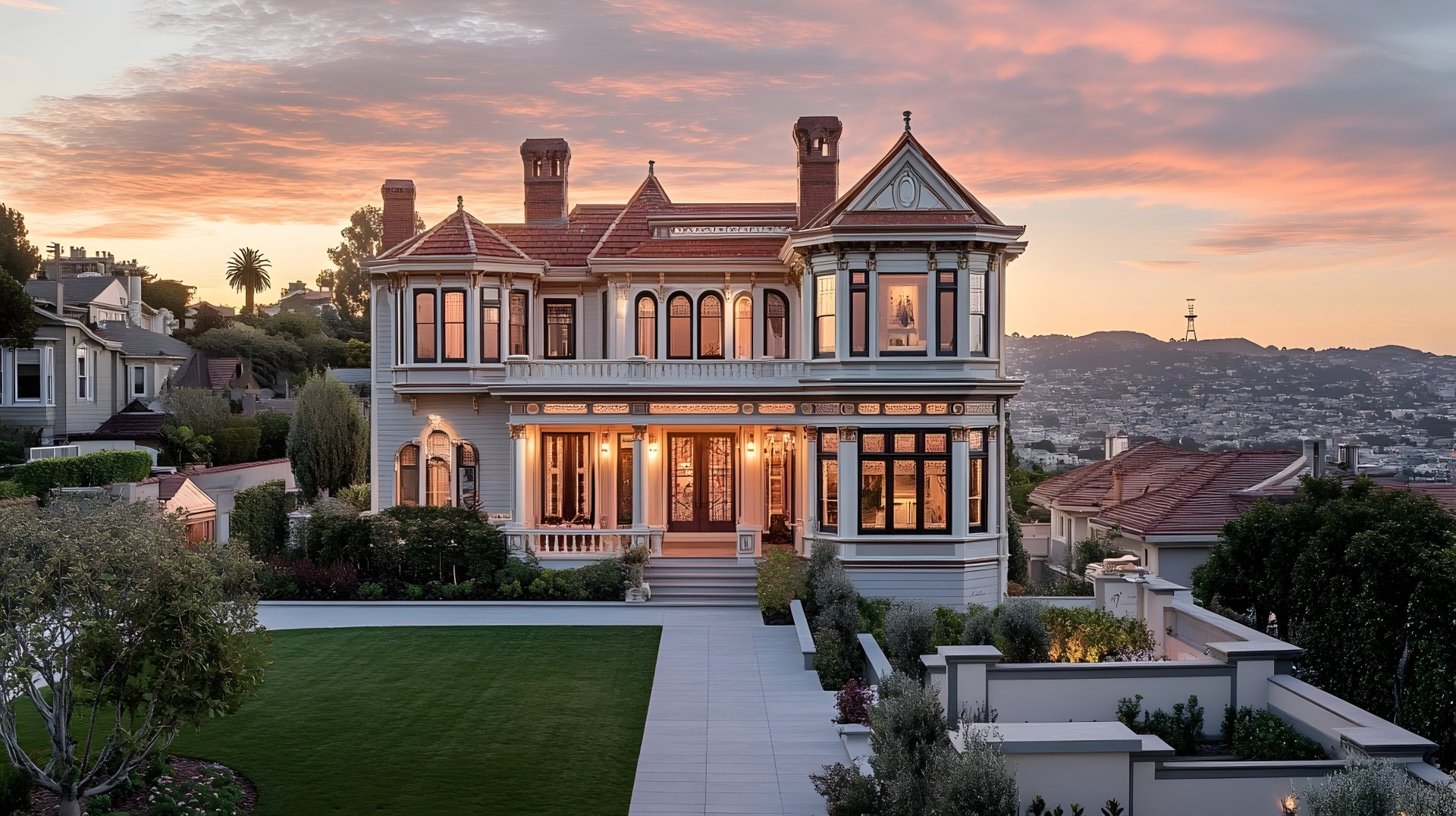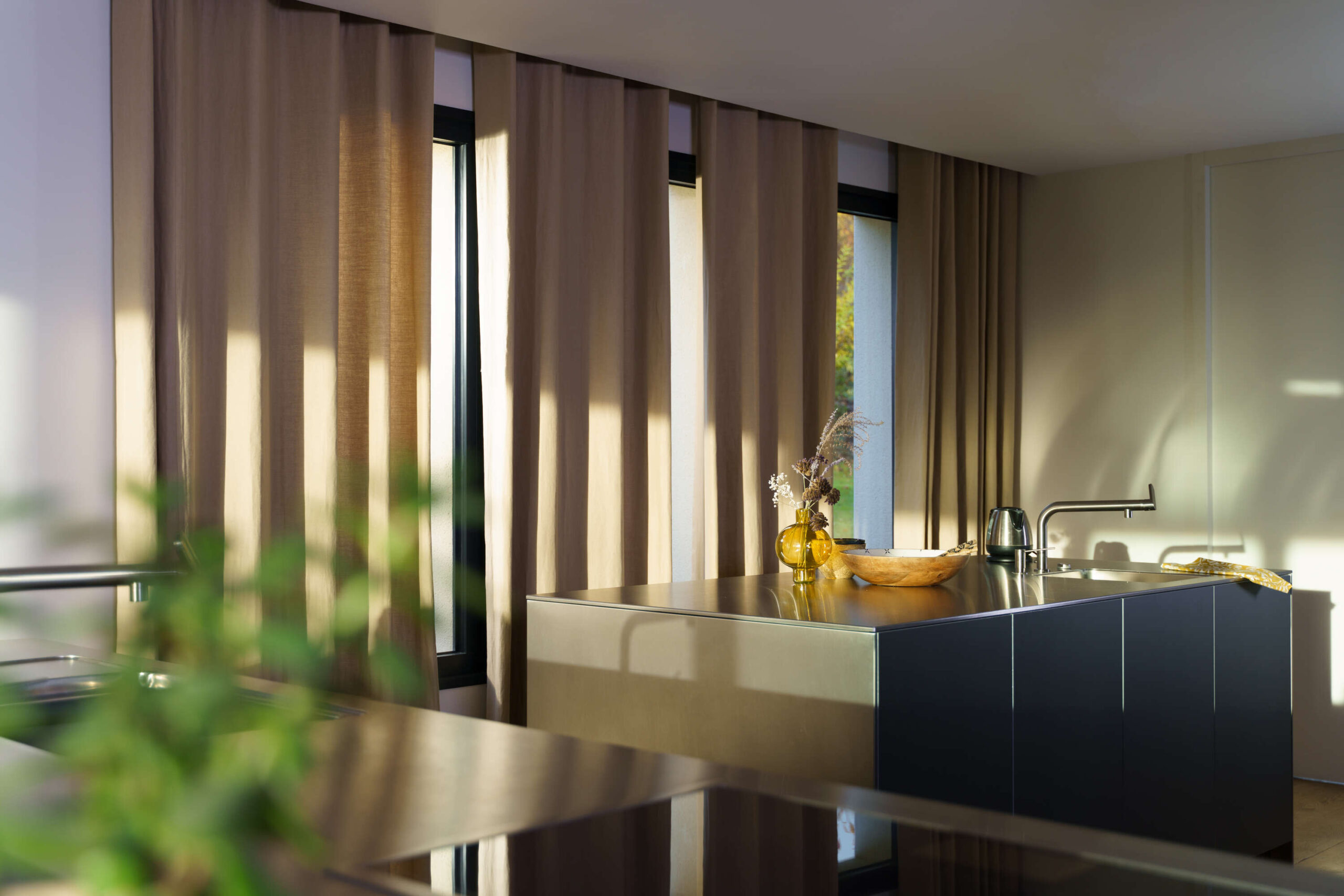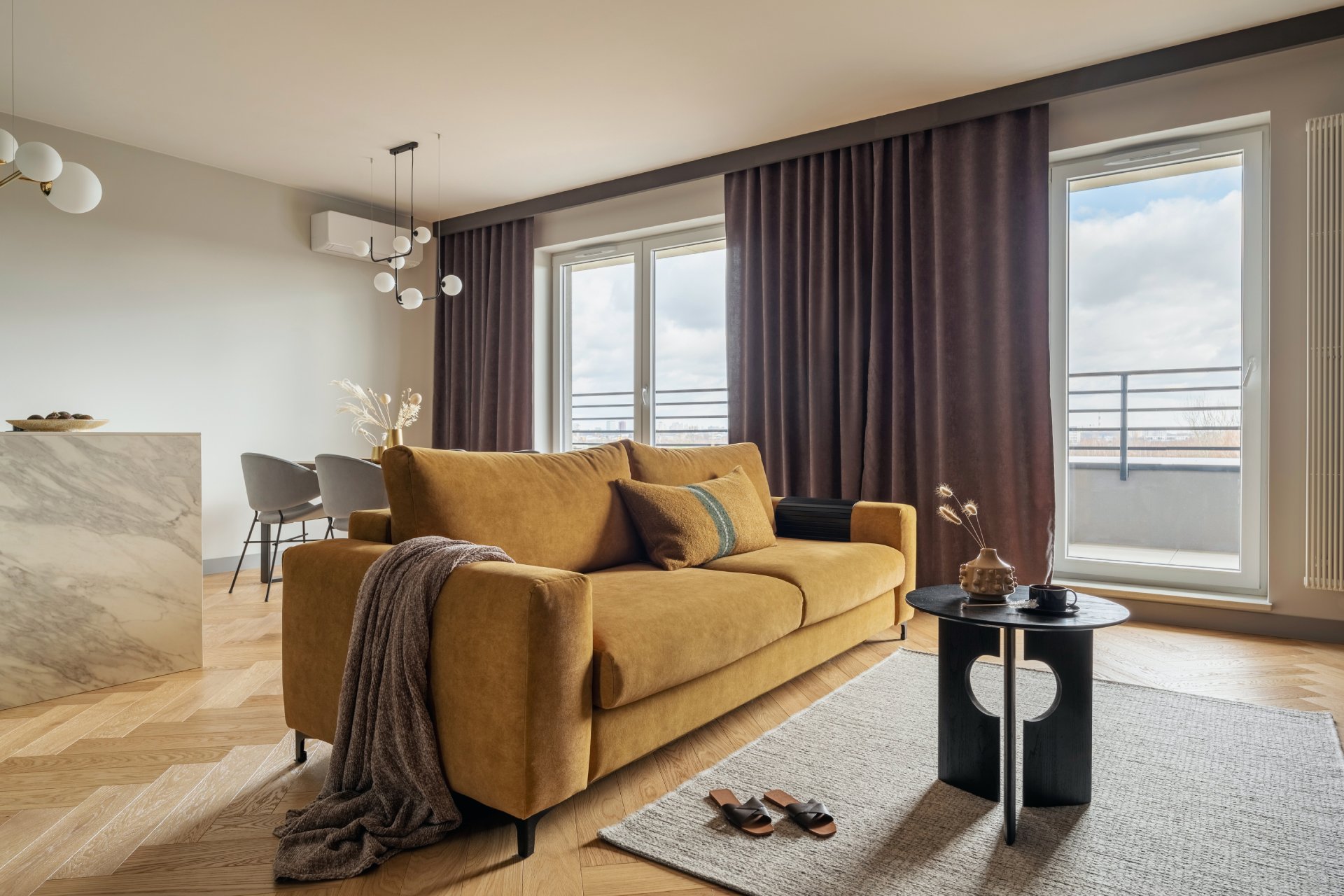Australia is home to an extraordinary variety of heritage homes, from elegant Edwardians and intricate Victorians to the breezy charm of Federation bungalows and the solid character of Georgian farmhouses. These properties are treasured for their craftsmanship, detailing, and sense of history—but when it comes to interior furnishings like curtains, they also demand a sensitive and strategic approach.
Australian made custom curtains play a vital role in enhancing these original features without overpowering them. The right fabric, heading, length, and track system can not only preserve the integrity of the home but change it into a luxurious and liveable space that blends comfort with classic character. Whether you’re an interior designer working on a major renovation, a curtain installer navigating unusual window sizes, or a homeowner seeking the perfect finish, here’s how to approach pairing custom curtains with heritage features.
1. Understand the Home’s Architectural Language
Before selecting fabrics or finishes, it’s essential to understand the period and style of the home. Different eras favoured different proportions, trims, and motifs:
Victorian homes (c. 1840–1900) are known for their grand proportions, with tall ceilings, decorative plasterwork, ornate cornices, and large double-hung sash windows. These interiors lend themselves to luxurious, full-length curtains in rich fabrics like velvet, damask, or silk—often paired with decorative rods or pelmets to reflect the era’s opulence and formality.
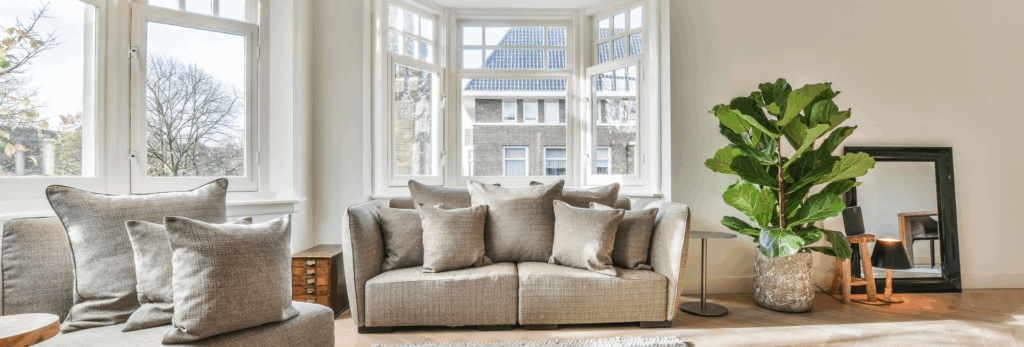
Edwardian homes (c. 1901–1915) embrace lighter interiors and more restrained ornamentation than their Victorian predecessors. Common features include high ceilings, wide timber architraves, timber fretwork, and elegant leadlight windows. Curtains in Edwardian homes should feel refined but not heavy—think soft linen or cotton blends, tailored pinch pleats, and classic patterns that echo the home’s more delicate aesthetic.
Federation homes (c. 1890–1915), which overlap the Edwardian period but with a distinctly Australian character, often include deep verandas, decorative gables, red brickwork, and bay windows. Interiors typically feature ornate ceiling roses, pressed metal panels, and stained glass. Sheer curtains that filter light through colourful glass, layered under functional blockout drapes, work beautifully here. Decorative rods or timber poles complement the traditional joinery.
Georgian homes (c. 1788–1840), though rarer in Australia, are admired for their symmetry, proportion, and understated elegance. These homes suit simple, refined window treatments in natural fabrics like linen or cotton. Box pleats or pencil pleats in solid, neutral tones echo the timeless restraint of the Georgian style, often mounted on discreet rods or inside architraves to preserve the architectural harmony.
The curtain design should feel like a natural extension of these architectural cues—not a modern afterthought.
2. Respect Original Windows—But Add Comfort and Function
Many heritage homes retain original windows that, while beautiful, are often draughty, single-glazed, or unusually proportioned. Here, custom curtains do double duty: preserving the aesthetic while improving insulation, privacy, and light control.
For tall double-hung sash windows or French doors, floor-length blockout curtains with a separate sheer layer offer both performance and elegance. Installers should pay close attention to proportions and ensure rods or tracks don’t interfere with period cornices, architraves, or picture rails. Ceiling-mounted or face-fix tracks can be designed to suit the architecture, especially with powder-coated finishes that blend into the background.
3. Fabric Selection: Match Mood, Material and Movement
Heritage homes call for fabrics that feel luxurious and timeless. While modern synthetics can offer performance benefits, natural fibres often sit more comfortably in these older interiors.
Best curtain fabric types for heritage homes:
Linen and linen blends – Breathable, softly textured, and available in wide-width sheers and heavier weights. Ideal for casual yet refined looks in Federation or Arts & Crafts homes.
Cotton and cotton blends – A classic choice that suits almost any heritage style. Crisp and versatile, it works well for tailored headings and prints.
Velvet – A beautiful option for grand rooms or period drama. Rich and heavy, it offers excellent insulation and presence, especially in Victorian or Georgian interiors.
Silk or faux silk – Adds sheen and drape but may need a protective lining to withstand UV in sunny climates.
Wool blends and heavy weaves – Textural and cosy, perfect for colder climates and formal rooms.
For a truly cohesive finish, many clients appreciate being able to choose from designer collections by Basford Brands, Warwick, James Dunlop, Mokum, Hoad, or Zepel—brands that offer sophisticated palettes, textures, and patterns suited to heritage interiors.
4. Selecting Colours and Patterns That Complement Original Features
Colour should never compete with existing architectural elements. Instead, it should complement timber tones, leadlight glass, original floorboards, and tiled fireplaces.
Neutrals such as ivory, oat, and soft greys work well with most wall colours and architectural timber trims.
Sage, ochre, rust, and navy draw from nature and heritage tile colours, ideal for Federation and early 20th-century schemes.
Florals, damasks, and stripes can enhance period charm—but must be used thoughtfully. Smaller-scale patterns suit intimate rooms; larger-scale prints can suit dining rooms or formal sitting areas.
Custom curtain fabric samples are essential here. They allow designers and homeowners to test how a fabric behaves in the light, interacts with wall colours, and fits the overall scheme.
5. Choosing the Right Heading Style
Heading style influences how the curtain falls, and how traditional—or modern—the final look feels. In heritage settings, the right heading can make or break the design.
Pencil pleat – Classic and versatile, it suits most heritage settings, especially when used with a decorative rod and rings.
Double or triple pinch pleat – More formal and structured, this heading style works beautifully in grand rooms and with heavier fabrics.
Inverted box pleat – Clean and tailored, perfect for a slightly more contemporary take on period charm.
Wave fold – Generally better suited to modern interiors, though it can work in heritage settings when paired with sheers or minimal hardware in transitional designs.
The curtain’s heading should reflect the home’s level of formality. For example, a triple pinch pleat in a formal sitting room, and a softer pencil pleat in a sunroom or bedroom.
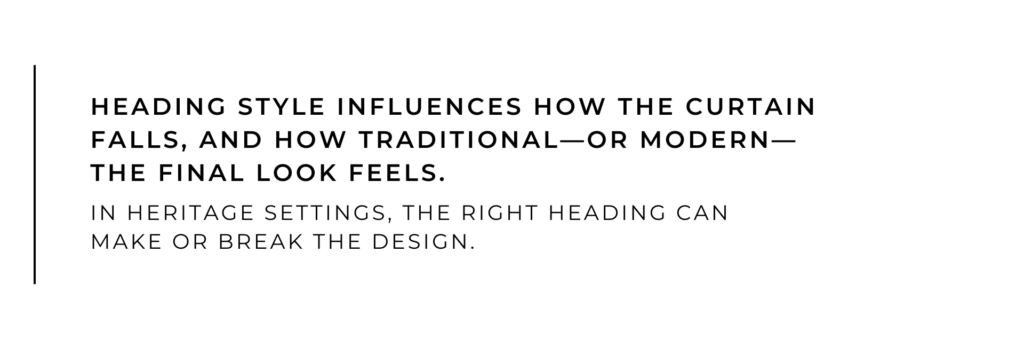
6. Pairing with Original Timberwork and Decorative Details
Architraves, panelling, wainscoting, picture rails, and ceiling roses are common in heritage homes. Rather than hiding them, curtain solutions should frame and respect these details.
Tips for balancing curtains and features:
Face-fix rods and tracks: Mount just above the architrave if the home has a strong horizontal detail like a picture rail. Choose classic finishes like antique brass, matte black, or powder-coated white.
Recessed curtain tracks: Where possible (such as in renovated heritage extensions), consider ceiling-recessed tracks for a clean and elegant finish that doesn’t compete with ornate plasterwork.
Sheer underlays: These allow decorative windows like leadlight to remain visible while still providing privacy.
Tiebacks or holdbacks: Can feel dated if overdone, but a simple fabric tie in a matching or complementary tone can suit formal settings.
7. Managing Irregular or Oversized Windows
One of the joys—and challenges—of working with heritage homes is their variety. You may be dealing with bay windows, arched windows, double-height voids, or uneven original installations. Here, made-to-measure curtain track solutions truly shine.
Bay windows: Custom-bent tracks and curtain headings that follow the angle of the bay are essential for a seamless look. A continuous wave or pleated curtain can soften the angles.
Arched windows: Rather than trying to cover the arch, consider a track mounted just above it, allowing the shape to remain a feature.
Tall windows and voids: These often require ceiling-mounted tracks and double-height curtain drops. Installers should always measure at three points to account for uneven floors or ceilings.
This is where working with experienced curtain installers and Australian made curtain manufacturers becomes essential—there’s no margin for error when fitting a 3.6m drop velvet drape in a formal Victorian parlour.
8. Lining and Layering for Performance and Privacy
Curtains in heritage homes need to be more than decorative. They must deliver on light control, insulation, and UV protection—especially given Australia’s climate.
Recommended curtain layers for heritage interiors:
Sheer layer: Provides privacy while allowing light and architectural details (like stained glass) to shine through. Can be hung on a double track or used alone in bright rooms.
Blockout layer: Protects against heat and light. Essential in bedrooms and west-facing rooms.
Interlining: A middle layer that adds body and improves insulation—particularly valuable in cold regions or with thin original glass.
Australian made curtains with high-quality linings also last longer, protect furniture and flooring, and improve energy efficiency.
9. Hardware and Curtain Tracks That Complement the Interior
The curtain track or rod is just as important as the curtain itself. In heritage homes, it’s important to choose high-quality hardware that supports the overall look—both visually and structurally.
Options to consider:
Decorative rods: With finials and rings in finishes such as antique brass, iron, or painted timber.
Minimalist powder-coated tracks: Ideal for keeping the focus on the curtains or when mounting inside pelmets or recesses.
Motorised tracks: Particularly useful in hard-to-reach areas such as stairwells, or in luxury renovations where automation is a priority. Modern systems like Somfy and others can be integrated discreetly.
Custom tracks from MAC Window Fashions are designed to handle unique window shapes, extra-long drops, and curved profiles—perfect for heritage homes that require flexibility and quality.
10. Final Touches: Styling, Draping and Installation
Once the curtain is selected, the final installation and styling make all the difference. Here are a few tips:
Break or kiss the floor? In formal homes, a generous break (2–3cm pooling on the floor) adds a sense of luxury. In more casual heritage settings, a ‘kissing the floor’ finish looks clean and refined.
Steam after installation: Heritage homes can be dusty, and steaming ensures the fabric falls beautifully and removes creases from packing.
Hardware maintenance: Ensure rods and tracks are securely anchored, especially in older walls. Curtain installers may need to adjust or reinforce mountings depending on the condition of the surfaces.
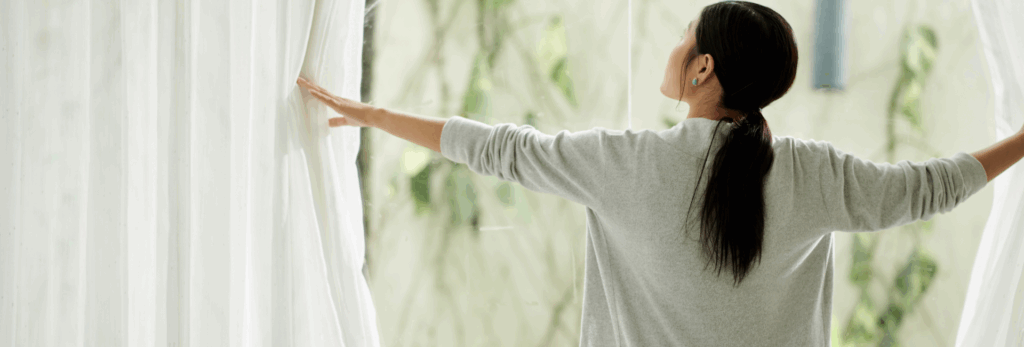
The Perfect Pairing: Past Meets Present
Pairing custom curtains with original heritage features is about more than aesthetics—it’s about enhancing and protecting the legacy of the home. It requires an eye for detail, a respect for history, and a commitment to quality craftsmanship.
Whether you’re restoring a grand Victorian terrace or refreshing a Federation bungalow, Australian made curtains give you the flexibility to match period charm with modern performance. With the widest range of curtain fabric samples, tailored heading options, and expert installation, MAC Window Fashions works with interior designers and installers across Australia to bring custom heritage curtain visions to life.
Work with MAC Window Fashions for Custom Australian Made Curtains TodayWe specialise in Australian made, luxury custom curtains designed to suit homes with history. From curved tracks to elegant sheers, heavy blockouts to full automation compatibility, MAC Window Fashions partners with Australia’s leading retailers and installers to deliver luxury, made-to-measure solutions that respect tradition and enhance everyday living. Explore our full curtain fabric range, request fabric samples, find out more about our curtains, or become a retail partner today.


